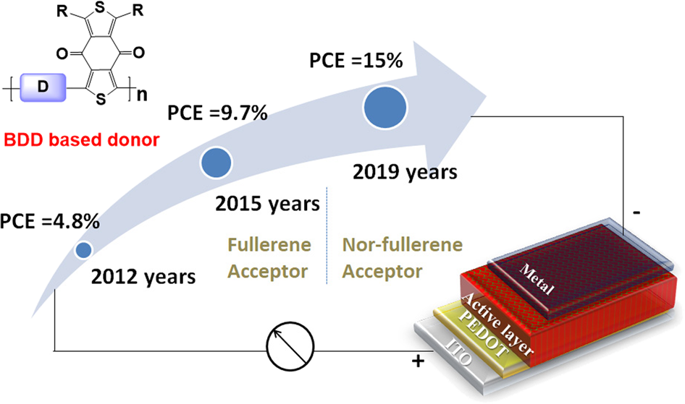NPG Asia Materials ( IF 8.6 ) Pub Date : 2020-01-24 , DOI: 10.1038/s41427-019-0163-5 Bing Zheng , Lijun Huo , Yongfang Li

|
Over the past 20 years, significant progress has been made in organic photovoltaics (OPVs) due to its advantages of being cost-effective, being lightweight, and having flexible manufacturability. The optical-active layer of OPVs consists of a p-type polymer as the donor and an n-type small molecule as the acceptor. An efficient design strategy of a polymer donor is based on an alternating electron-donating unit (D) and an electron-accepting unit (A). Among numerous electron-accepting units, an emerging annelated thiophene of benzodithiophenedione (BDD) has exhibited a distinguished photovoltaic performance because of its planar molecular structure, low-lying highest occupied molecular orbit (HOMO) level and good self-assembly property. In this review article, we summarize the most recent developments in BDD-based photovoltaic materials. Special attention is paid to the chemical structure-property relationships, such as the absorption, bandgap, energy levels, mobilities, and photovoltaic performances. The empirical regularities and perspectives on the future development of BDD-based photovoltaic materials are included.
中文翻译:

基于苯并二噻吩的聚合物:有机光伏的最新进展
在过去的20年中,有机光伏(OPV)由于其具有成本效益,重量轻和可制造性强的优势而取得了重大进展。OPV的光学活性层由作为供体的p型聚合物和n型小分子作为受体。聚合物供体的有效设计策略是基于交替的电子给体单元(D)和电子接受单元(A)。在众多的电子接受单元中,新兴的苯并二噻吩二酮(BDD)的退火噻吩由于其平面分子结构,低位的最高占据分子轨道(HOMO)水平和良好的自组装特性而具有杰出的光电性能。在这篇评论文章中,我们总结了基于BDD的光伏材料的最新发展。要特别注意化学结构与性质之间的关系,例如吸收,带隙,能级,迁移率和光伏性能。包括基于经验的规律性和对基于BDD的光伏材料未来发展的看法。











































 京公网安备 11010802027423号
京公网安备 11010802027423号